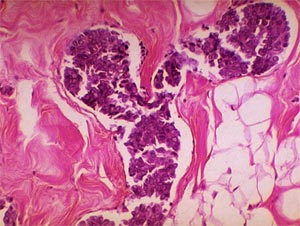Breast Cancer Treatment

Appropriate breast cancer treatment is decided on the basis of a number of factors. Surgery and chemotherapy are often used in combination. It has become imperative for the woman of today to become aware of the need for a healthier lifestyle, one that will promote good health and keep cancer at bay. Learn more about breast cancer treatment side effects.
Breast Cancer Treatment
Breast cancer treatment will depend on a number of factors such as size and location of the breast lump, the stage at which it was detected and the results of hormone receptor tests. Recommendations of the National Institute of Health (NIH) include chemotherapy for treatment of localized breast cancer.
Hormone therapy was suggested as breast cancer treatment for tumors containing estrogen receptors. Mastectomy and lumpectomy patients were advised to go in for radiation therapy after surgery. New and radical breast cancer treatments have brought hope to the hearts of those suffering from this form of the Big C. Earlier, surgery was always seen as the first line of attack.
Lumpectomy is the surgical removal of a cancerous tumor along with a small margin of surrounding tissue. This breast cancer treatment is best when performed at Stage 0, Stage I or Stage II breast cancers.
Mastectomy is the surgical removal of the affected breast. This may not necessitate removal of all lymph nodes.
Chemotherapy is breast cancer treatment with anti-cancer drugs administered intravenously or orally. This systemic form of treatment is either administered alone or along with surgical procedures. Chemotherapy is a systemic therapy that affects the entire body by entering the bloodstream. This is used widely in breast cancer treatment to interfere with rapidly dividing cells.
Radiation is the use of high-energy rays to prevent breast cancer cells from further growth and division. Though normal cells are also affected by this form of breast cancer treatment, they generally repair themselves and function normally afterwards.
Tamoxifen drug therapy is used to block estrogen in the breast and thereby slow down the growth and reproduction of cancer cells. Herceptin is a U.S. Food and Drug Administration (FDA) approved drug for treating women with metastatic breast cancer. Hormonal therapy is used as a systemic treatment to block the effects of estrogen and progesterone that have the potential to promote growth of breast cancer.
Breast Cancer Treatment side effects
Breast cancer treatment leads to many unpleasant side effects, primarily loss of appetite. Some patients experience nausea and vomiting during breast cancer treatment. This usually leads to fatigue and resultant weakness. Some women undergoing breast cancer treatment notice dull aches or sharp shooting pain in the breast. The skin tends to become dry and itchy.
Another oft-noticed side effect of breast cancer treatment is the reduced resistance to infections. This is largely due to the disrupted production of white blood cells. Patients might also notice changes in gastrointestinal function such as vomiting, diarrhea and heartburn.
Chemotherapy for breast cancer leads to hair thinning or hair loss in most women. But this usually is reversed once the treatment is stopped.
Breast cancer awareness
Finding a breast lump doesn't mean that you are suffering from breast cancer. More often than not, such breast lumps are benign. It is therefore essential that women become aware of the issues that affect their health so that they can schedule regular medical visits and mammograms. Breast cancer awareness can help in adopting a healthier lifestyle that will effectively lower your risk of contracting the disease.
- Aim to stop smoking, for good
- Make exercise a part of your daily regimen
- Improve the quality of your life by reducing stress
- Limit your consumption of alcohol
- Avoid taking estrogen-like products in case you have already had breast cancer.
Fibrocystic breast disease
Fibrocystic breast disease is a benign condition that is characterized by round lumps that move freely within the breast tissue. In contrast to a cancerous growth that is not tender or freely movable when touched, these fibrocystic growths are soft. They may increase during prior to menstruation since fibro cysts fill with fluid and enlarge due to increased hormonal levels.
Estrogen and prolactin are the main hormones that affect these fibro cysts. With repeated hormonal stimulation month after month, the Breast Cysts become chronically inflamed and thicken due to the fibrous tissue around them.
This makes it difficult for the fluid contained within to escape. A needle aspiration is generally performed by physicians to remove this trapped fluid within the cysts. This relieves the pressure on the surrounding tissue thereby reducing the pain.
A mammogram helps to distinguish fibrocystic breast disease from breast cancer. A surgical biopsy is done if there are any doubts. A high fiber diet supplemented with plant-based foods, fruits and vegetables can help in preventing cyclical fluctuations in the cyst size. Fish can help reduce fibrocystic breast disease on account of its iodine content and healthy oils.
Top of the Page: Breast Cancer Treatment
Tags:#breast cancer treatment #breast cancer awareness #breast lump #fibrocystic breast disease

Cancer Staging and Grading
Mammogram - Breast Xray
Breast Ultrasound
Breast MRI
Breast Augmentation
More on Breast cancer

Stress and Breast Cancer
Breast Density and Breast Cancer Risk
Lower your Breast Cancer Risk
Breast Cancer Myths
Mastitis
Breast Cancer Awareness
Preventing Breast Cancer
Breast Self Exam
Breast Cancer Chemotherapy Treatment
Palpable Breast Mass
Breast Cyst
Breast Cancer Symptoms
Breast Calcification
Breast Cancer Treatment
Mastectomy
Top of the Page: Breast Cancer Treatment
Popularity Index: 100,665

